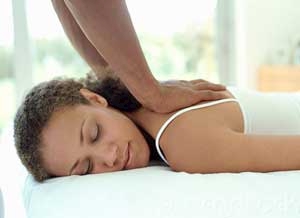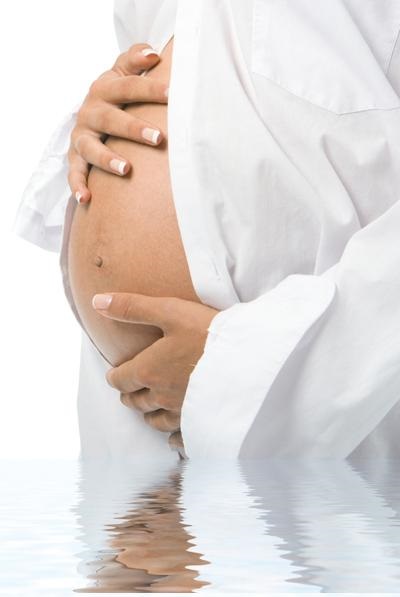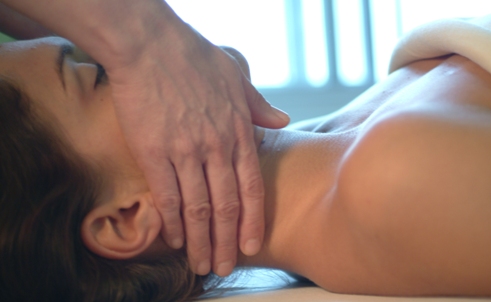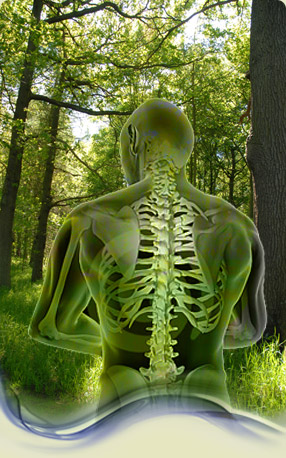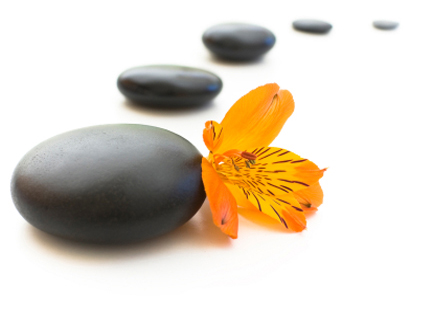Contact Us
Bodywork Menu
(incl. Prices)
Massage as Medicine
Driving
Directions |
|
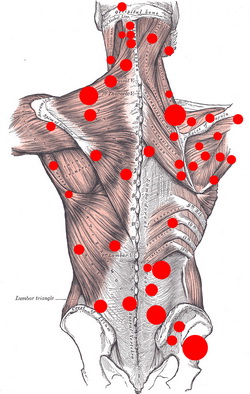
Referral Patterns of Triggerpoints
|
Pain referral area
|
Check these area
|
|
Low Back
|
rectus
abdominus, psoas, quadratus lumborum, piriformis
|
|
Shoulder
|
sub occipitals,
scalenes, SCM, infraspinatious, subscapularis, pectoralis major and minor,
facet joints in the neck
|
|
Thigh
|
psoas, TFL,
iliacus
|
|
Sciatica
|
piriformis,
quadratus lumborum, serratus posterior inferior,
|
|
Knee
|
Quadriceps,
adductors, psoas, hamstrings, sartorius
|
|
ankle/foot
|
psoas, TFL,
adductors
|
|
headaches
|
sub-occipitals,
scalenes, levator scapulae, rhomboids
|
|
| |
Triggerpoint
Definitions
Definitions:
Trigger point - (Myofascial): An area of
hyper-irritability within soft tissue structures, characterized by local
tenderness and sometimes referred phenomena. These referred sensations
can include pain, tingling, numbness burning, or itching.
- Not all trigger points refer pain, some are just
localized. Each person is different depending on their life history.
- Localized areas of deep tenderness and increased
tissue resistance that often produce referred pain.
- The origin of the trigger point is thought to be
changes in the chemical balance in a local area, irritating the sensory
systems.
Active
trigger point: Cause
of the immediate pain, prevents muscle from fully lengthening and
sometimes weakens.
Latent trigger point: Unnoticed by the client until pressure is
applied, Not actively painful. Usually feels dense and fibrous.
Characteristics
- Trigger points may be associated with Vitamin
B-6 and other vitamin deficiencies. Usually after a trauma or
stressful event, the body is lacking in B-6, magnesium or Vitamin C.
Trigger points are more likely to develop.
- Trigger point are usually bilateral, with one
side being more symptomatic than the other. Both sides need to be
treated.
- Trigger points may be a result of underlying
visceral disease, arthritic joints, or other trigger points.
- The most tender trigger points are usually not
the source of the problem. Other areas need to be treated like the
referral area and the surrounding tissue. Look for tight stringy
band in small supporting musculature.
- Trigger points can cause referred pain, but not
always.
- The referral patterns are not the same in any 2
people.
- Referred pain does not follow segmental,
scleratomal or dermatomal patterns.
- May cause pain and stiffness especially after
periods of inactivity such as sleeping or sitting for awhile.
Possible Causes:
- Acute overload, overwork, fatigue, direct
trauma, chilling
- skeletal asymmetry such as short leg or pelvic
imbalances.
- Other triggerpoints can cause new points to
occur
- arthritic joints can cause triggerpoints
- Visceral diseases such as ulcers, renal colic,
myocardial infarction, gall stones, kidney problems, irritable bowel
syndrome can cause triggerpoints.
- B-6, magnesium, vitamin C, folic acid deficiencies
which are common after injuries or trauma may cause triggerpoints
- hypoglycemia
- chronic infection from a viral or bacterial
disease.
- food allergies or intolerances. Wheat and
dairy products should be checked first.
- toxicity due to exposure to organic chemicals or
heavy metals
Location:
Trigger points may develop any
where in the body, but are most commonly found at the sites of the greatest
mechanical and postural stress.
Hints for locating:
- look for changes in thickness of tissue, resistance
to gliding strokes, lumps or strings.
- immobility
- edema
- pain or tenderness
- temperature changes-area is usually colder
- color most often somewhat pale and
unhealthy looking
- muscle shortening with weakness
- occasionally increased perspiration in reference
zone
- hypertonicity
- ischemia
Factors that can worsen
trigger points:
- fatigue, improper sleep
- chronic infection
- severe stress (mental, emotional, physical)
- nerve entrapment, compression
- excessive creatine in urine
- postural imbalances
- nutritional health of the tissue
- food allergy, inhalant allergy
- visceral (organ) disease - gall bladder
problems, ulcers, kidney problems, irritable bowel syndrome
- exercise may worsen an active triggerpoint, but
helps heal a latent triggerpoints
Signs of Triggerpoints:
- restricted movement, stiffness of muscles
- weakness in muscles
- passive or active stretching increases pain
- resisted contraction causes pain
- subcutaneous tissue feels coarsely granular,
ropy, knotty,
- client "jumps" when pressure applied
to triggerpoint
- deep tenderness and paresthesia
- client may feel "Numb" but sensation
is normal
- dizziness
- taut palpable band in the affected muscle
- exercise makes the pain worse when there are
active triggerpoints, but helps heal the latent triggerpoints
- hyperirritability, increased metabolism,
decreased circulation
Thing to pay attention to:
- What layer of tissue are you working on?
- How can you work more efficiently?
- What does the tissue feel like? How does
it change?
- What other areas may be associated with the
trigger point?
Cautions:
- Triggerpoint therapy can relieve the pain of
angina, myocardial infarction and acute abdominal disease. Refer
clients to physicians when necessary.
- Rule out such conditions as: Tendinitis,
bursitis, giant cell arteritis, neuralgia, infection (both viral and
bacterial), neuropathies, disc problems, disc herniations.
- Check for thyroid malfunction, anemia,
hypoglycemia and vitamin deficiencies.
Triggerpoint Treatments
Firm digital pressure causes hypoxia
and reactive hyperemia that clears the triggerpoint. Reconditioning the
muscle after the pain is reduced makes latent triggerpoints less prone to
reactivate.
Treatment Method I:
1. Treat superficial
trigger points first, applying 8-30 seconds or until the pain is gone as the
client permits. Notice changes in feel and pain intensity ( ask
client for feedback regarding pain intensity).
2. Are there any referral
patterns?
3. Flush the area with deep
effleurage, pettrisage or friction.
4. Return to same trigger point
and repeat treatment, 3-4 times removing as much of the pain as possible.
5. If the pain intensifies,
just hold for a few more seconds and go back later.
6. You can vary the
intensity of pressure gradually, moving with the point as it changes and
releases.
Advanced
Technique: Treat as many trigger points as you can in the area and
related area and throughout the body.
CAUTION:
Do not do this unless you know how to ground a client properly. Watch for sweating palms or feet, feelings of nausea
or dizziness. This indicates sympathetic over stimulation. Emotional
release may also be triggered with such intense work. Pulling clients
fingers and toes should be done after such intense treatments, for grounding.
Hold clients wrist with one hand and grab little finger with the thumb and
forefinger, wrapping the hand around the little finger. Gently, but
firmly begin pulling the little finger and let go of their wrist and continue
pulling finger until you snap off the end. Grab the wrist again as you
complete the snap to hold the hand up (do not let the hand/arm fall)
Continue with ring finger, middle finger, index finger and thumb. Repeat
as necessary. Repeat with toes, pulling each toe and releasing. The
pull must come from your center and be pulled from the clients center
(abdominal area). Can you see the abdomen move when you pull the fingers
or toes?
- Ice can be applied after session or
recommend client to ice at home.
- Client must follow up with high intake of water to flush
the toxins and a detox bath consisting of 1 cup epsom salt, 1 cup sea salt
and 1 cup baking soda.( or walk in the ocean or other body of salt
water). This will eliminate detox symptoms such as headaches and
fatigue.
- Also following up with movement re-education
exercises will integrate the changes into the nervous system.
|
